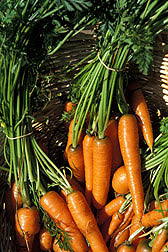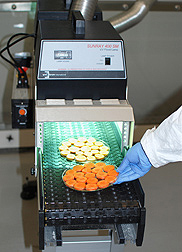Ultraviolet Light Boosts Carrots’ Antioxidant Value
|
|
Exposing sliced carrots to UV-B, one of the three kinds of ultraviolet light in sunshine, can boost the antioxidant activity of the colorful, crunchy veggie. That’s according to preliminary studies by Tara H. McHugh, a food technologist and research leader at the ARS Western Regional Research Center in Albany, California, and her team.
Found mainly in fruits and vegetables, antioxidants are natural compounds that may reduce risk of cancer and cardiovascular disease.
The carrot investigation, conducted by McHugh, postdoctoral associate Wen-Xian Du, and others, suggests that a moderate, 14-second dose of UV-B can boost fresh, sliced carrots’ antioxidant capacity by about threefold. The dose is energy-efficient and does not significantly heat or dry the carrots.
Scientists have known for at least a decade that exposing plants to UV-B may cause what’s known as “abiotic stress.” That’s what likely happened with the sliced carrots, McHugh says.
Plants respond to abiotic stress by revving up their production of two natural enzymes, polyphenylalanine ammonia-lyase and chalcone synthase. As production of those enzymes increases, levels of phenolics, compounds synthesized by the enzymes, also increase. Some phenolics are antioxidants.
Despite this and other knowledge about plants’ responses to stress and to UV-B, the idea of using UV-B to quickly, safely, and conveniently enrich the antioxidant heft of fresh produce hasn’t been extensively studied, McHugh says.
|
|
The carrot research, which McHugh has reported at annual meetings of the American Chemical Society and the Institute of Food Technologists, is helping fill in the knowledge gap. So will similar, ongoing studies at the Albany lab, funded by ARS and by a grant awarded to McHugh and Albany co-investigator Andrew Breksa in 2009 by USDA’s National Institute of Food and Agriculture.
In earlier research, McHugh and colleagues worked with the Mushroom Council, based in San Jose, California, and Monterey Mushrooms, Inc., of Watsonville, California, to explore the potential of using UV-B to boost the vitamin D content of mushrooms. The idea was not new but, at the time, had yet to be commercialized.
Mushrooms are rich in ergosterol, which can be converted by sunlight into vitamin D. But since commercial mushrooms are typically grown in the dark, their vitamin D levels are usually low. McHugh and Monterey Mushrooms worked out a practical procedure for using UV-B at the packinghouse to capitalize on mushrooms’ ergosterol. That resulted in the company’s 2008 launch of its line of vitamin D-rich mushrooms, the first-ever commercial use of UV-B to increase mushrooms’ vitamin D content.
The researchers documented some of their mushroom studies in a 2008 article in the Journal of Agricultural and Food Chemistry. Now, physiologist and research leader Charles Stephensen is looking at bioavailability, that is, how available the mushrooms’ vitamin D is to our bodies.
Stephensen, based at the ARS Western Human Nutrition Research Center in Davis, California, is comparing availability of the vitamin from treated and untreated mushrooms and from vitamin D capsules. ARS and the Mushroom Council are funding the study.—By Marcia Wood, Agricultural Research Service Information Staff.
This research is part of Quality and Utilization of Agricultural Products, an ARS national program (#306) described at www.nps.ars.usda.gov.
Tara H. McHugh is in the USDA-ARS Processed Foods Research Unit, Western Regional Research Center, 800 Buchanan St., Albany, CA 94710; (510) 559-5864.
Charles B. Stephensen is in the USDA-ARS Immunology and Disease Prevention Research Unit, Western Human Nutrition Research Center, 430 W. Health Sciences Dr., Davis, CA 95616; (530) 754-9266.
"Ultraviolet Light Boosts Carrots’ Antioxidant Value" was published in the January 2011 issue of Agricultural Research magazine.








